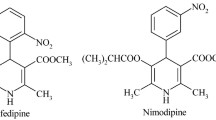Abstract
Purpose. P-glycoprotein (P-gp) is made responsible for the limited oral bioavailability of P-gp substrates like peptidic HIV protease inhibitors (PIs). With respect to combined application of two PIs in antiretroviral regimes, we first investigated the influences on intestinal saquinavir uptake using different PIs in in situ perfusion studies.
Methods. Perfusion experiments were carried out in three intestinal segments with P-gp substrates talinolol and saquinavir using fixed concentrations of PIs and with each varying concentrations in the jejunum and ileum. Furthermore, cellular uptake of fluorescent P-gp substrate rhodamine-123 and MRP-substrate carboxyfluorescein has each been quantified in P-gp and MRP-expressing cells by flow cytometry under co-adminstration of PIs.
Results. Increase of calculated permeabilities of P-gp-specific substrate talinolol was found under co-administration of both PIs, ritonavir and H17, with highest absorption rates in the ileal and colon segment. H17 proved to be a better P-gp inhibitor than ritonavir by resulting IC50 values and also in the cellular uptake of rhodamine. Similar increases of permeabilities in ileum and colon have also been found for saquinavir as P-gp as well as MRP-substrate with differences in the jejunal uptake, which was found higher for H17. Additional MRP-inhibitory activities of H17 were proved by increasing cellular uptake rates of carboxyfluorescein in MRP-expressing cells.
Conclusions. The investigated PIs were characterized as effective P-gp inhibitors in the intestinal absorption of P-gp substrates. H17 showed MRP-inhibitory effects that also favor intestinal drug absorption of corresponding substrates. With respect to combined therapeutic application of PIs, compounds like H17 raise hopes for improved bioavailability of poorly absorbed compounds.
Similar content being viewed by others
REFERENCES
X. Wie, J. M. Decker, H. Lui, Z. Zhang, R. B. Arani, J. M. Kilby, M. S. Saag, X. Wu, G. M. Shaw, and J. C. Kappes. Emergence of resistant immunodeficiency virus type 1 in patients receiving fu-sion inhibitor (T-20) monotherapy. Antimicrob. Agents Che-mother. 46:1896–1905 (2002).
A. Hilgeroth. Dimeric 4-aryl-1,4-dihydropyridines: development of a third class of nonpeptidic HIV-1 protease inhibitors. Min. Rev. Med. Chem. 2:235–245 (2002).
R. B. Kim, M. F. Fromm, C. Wandel, B. Leake, A. J. J. Wood, and D. M. Roden. The drug transporter P-glycoprotein limits oral absorption and brain entry of HIV-1 Protease inhibitors. J. Clin. Invest. 101:289–294 (1998).
L. Profite, V. A. Eagling, and D. J. Back. Modulation of P-glycoprotein function in human lymphocytes and Caco-2 cell monolayers by HIV-1 protease inhibitors. AIDS 13:1623–1627 (1999).
M. T. Huisman, J. W. Smit, H. R. Wiltshire, R. M. W. Hoetelmans, J. H. Beijnen, and A. H. Schinkel. P-Glycoprotein limits oral availability, brain, and fetal penetration of saquinavir even with high doses of ritonavir. Mol. Pharmacol. 59:806–813 (2001).
J. Drewe, H. Gutmann, G. Fricker, M. Török, C. Beglinger, and J. Huwyler. HIV Protease inhibitor ritonavir: a more potent in-hibitor of P-glycoprotein than the cyclosporine analog SDZ PSC 833. Biochem. Pharmacol. 57:1147–1152 (1999).
C. Leopold. HIV-protease inhibitors-an overview. Pharm. Uns. Zeit 30:234–239 (2001).
M. L. Newell. Mechanism and timing of mother-to-child trans-mission of HIV-1. AIDS 12:831–837 (1998).
G. Moyle and B. Gazzard. Current knowledge and future pros-pects for the use of HIV protease inhibitors. Drugs 51:701–712 (1996).
J. H. Lin, M. Chiba, I.-W. Chen, J. A. Nishime, F. A. Deluna, M. Yamazaki, and Y. J. Lin. Effect of dexamethasone on the intes-tinal first-pass metabolism of indinavir in rats: evidence of cyto-chrome P-450 A and P-glycoprotein induction. Drug Metab. Dis-pos. 27:1187–1193 (1999).
H. Spahn-Langguth, G. Baktir, A. Radschuweit, A. Okyar, B. Terhaag, P. Ader, A. Hanafy, and P. Langguth. P-glycoprotein transporters and the gastrointestinal tract: Evaluation of the po-tential in vivo relevance of in vitro data employing talinolol as model compound. Int. J. Clin. Pharmacol. Ther. 36:16–34 (1998).
H. Gutmann, G. Fricker, J. Drewe, M. Toeroek, and D. S. Miller. Interactions of HIV protease inhibitors with ATP-dependant drug export proteins. Mol. Pharmacol. 56:383–389 (1999).
A. Hanafy, P. Langguth, and H. Spahn-Langguth. Pretreatment with potent P-glycoprotein ligands my increase intestinal secre-tion in rats. Eur. J. Pharm. Sci. 12:405–415 (2001).
M. M. Cornwell, I. Pastan, and M. M. Gottesmann. Certain cal-cium channel blockers bind specifically to multidrug-resistant hu-man KB carcinoma membrane vesicles and inhibit drug binding to P-glycoprotein. J. Biol. Chem. 262:2166–2170 (1987).
A. Hilgeroth, C. Dressler, S. Neuhoff, H. Spahn-Langguth, and P. Langguth. Dimeric 4-aryl-1,4-dihydropyridines as novel HIV-1 protease inhibitors-affinities to intestinal P-glycoprotein. Pharmazie 55:784–785 (2000).
R. Yumoto, T. Murakami, Y. Nakamoto, R. Hasegawa, J. Nagai, and M. Takano. Transport of rhodamine 123, a P-glycoprotein substrate, across rat intestine and Caco-2 cell monolayers in the presence of cytochrome P-450 3A-related compounds. J. Phar-macol. Experim. Therapeut. 289:149–155 (1999).
S. D. Flanagan, C. L. Cummins, M. Susanto, X. Liu, L. H. Taka-hashi, and L. Z. Benet. Comparison of furosemide and vinblas-tine secretion from cell lines overexpressing multidrug resistance protein (P-glycoprotein) and multidrug resistance-associated pro-teins (MRP1 and MRP2). Pharmacology 64:126–134 (2002).
M. P. Draper, R. L. Martell, and S. B. Levy. Indomethacin-mediated reversal of multidrug resistance and drug efflux in hu-man and murine cell lines overexpressing MRP, but not P-glycoprotein. Br. J. Cancer 75:810–815 (1997).
Author information
Authors and Affiliations
Rights and permissions
About this article
Cite this article
Richter, M., Gy#x00E9;m#x00E1;nt, N., Moln#x00E1;r, J. et al. Comparative Effects on Intestinal Absorption in Situ by P-glycoprotein-Modifying HIV Protease Inhibitors. Pharm Res 21, 1862–1866 (2004). https://doi.org/10.1023/B:PHAM.0000045240.81664.be
Issue Date:
DOI: https://doi.org/10.1023/B:PHAM.0000045240.81664.be




